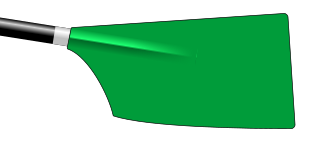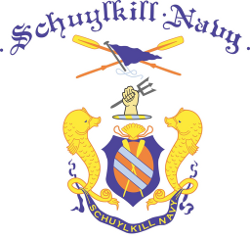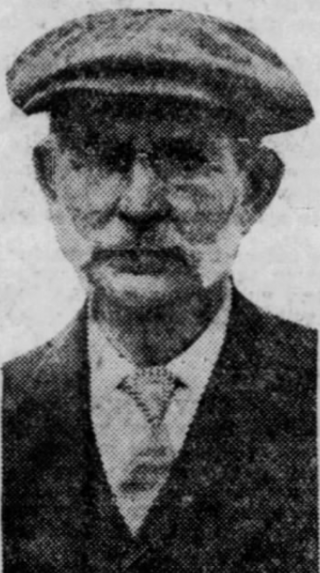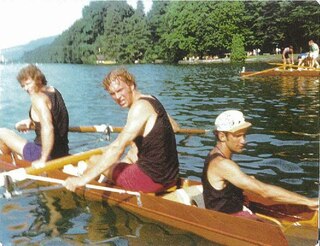Related Research Articles

Rowing, sometimes called crew in the United States, is the sport of racing boats using oars. It differs from paddling sports in that rowing oars are attached to the boat using oarlocks, while paddles are not connected to the boat. Rowing is divided into two disciplines: sculling and sweep rowing. In sculling, each rower holds two oars—one in each hand, while in sweep rowing each rower holds one oar with both hands. There are several boat classes in which athletes may compete, ranging from single sculls, occupied by one person, to shells with eight rowers and a coxswain, called eights. There are a wide variety of course types and formats of racing, but most elite and championship level racing is conducted on calm water courses 2 kilometres (1.2 mi) long with several lanes marked using buoys.

A head race is a time-trial competition in the sport of rowing. Head races are typically held in the fall, winter and spring seasons. These events draw many athletes as well as observers. In this form of racing, rowers race against the clock where the crew or rower completing the course in the shortest time in their age, ability and boat-class category is deemed the winner.

Rowing is the oldest intercollegiate sport in the United States. The first intercollegiate race was a contest between Yale and Harvard in 1852. In the 2018–19 school year, there were 2,340 male and 7,294 female collegiate rowers in Divisions I, II and III, according to the NCAA. The sport has grown since the first NCAA statistics were compiled for the 1981–82 school year, which reflected 2,053 male and 1,187 female collegiate rowers in the three divisions. Some concern has been raised that some recent female numbers are inflated by non-competing novices.

The Harvard–Yale Regatta or Yale-Harvard Boat Race is an annual rowing race between the men's heavyweight rowing crews of Harvard University and Yale University. First contested in 1852, it has been held annually since 1859 with exceptions during major wars fought by the United States and the COVID-19 pandemic. The Race is America's oldest collegiate athletic competition, pre-dating The Game by 23 years. It is sometimes referred to as the "Yale-Harvard" regatta, though most official regatta programs brand it "Harvard-Yale."
Harry Parker was the head coach of the Harvard varsity rowing program (1963–2013). He also represented the United States in the single scull at the 1960 Summer Olympics.
The Poughkeepsie Regatta was the annual championship regatta of the U.S. Intercollegiate Rowing Association (IRA) when it was held in Poughkeepsie, New York from 1895 to 1949.

The Stotesbury Cup Regatta, sponsored by the Schuylkill Navy, is the world's oldest and largest high school rowing competition. It is held annually in mid-May over a two-day period on the Schuylkill River near Boathouse Row in Philadelphia, Pennsylvania. Competing crews come from schools all over North America, though most hail from the Northeastern and Mid-Atlantic United States.

In a rowing crew, the coxswain is the member who does not row but steers the boat and faces forward, towards the bow. The coxswain is responsible for steering the boat and coordinating the power and rhythm of the rowers. In some capacities, the coxswain is responsible for implementing the training regimen or race plan. Most coaches cannot communicate to boat/coxswain, so the coxswain is the "coach" in the boat. A coxswain is necessary in the first place because the rowers sit with their backs to the direction of travel.

Jesus College Boat Club is a rowing club for members of Jesus College, Oxford, one of the constituent colleges of the University of Oxford. The club was formed in 1835, but rowing at the college predates the club's foundation: a boat from the college was involved in the earliest recorded races between college crews at Oxford in 1815, when it competed against Brasenose College. In the early years of rowing at Oxford, Jesus was one of the few colleges that participated in races. Neither the men's nor the women's 1st VIIIs have earned the title of "Head of the River", which is gained by winning Eights Week—the main inter-college rowing competition at Oxford.

The Schuylkill Navy is an association of amateur rowing clubs of Philadelphia. Founded in 1858, it is the oldest amateur athletic governing body in the United States. The member clubs are all on the Schuylkill River where it flows through Fairmount Park in Philadelphia, mostly on the historic Boathouse Row.
The Intercollegiate Rowing Association (IRA) governs intercollegiate rowing between varsity men's heavyweight, men's lightweight, and women's lightweight rowing programs across the United States, while the NCAA fulfills this role for women's open weight rowing. It is the direct successor to the Rowing Association of American Colleges, the first collegiate athletic organization in the United States, which operated from 1870–1894.

Ellis F. Ward was an American rower and coach best known for his time as the coach of the University of Pennsylvania rowing team. Ward was a member of one of the most famous families, the Ward Brothers, in the history of the sport of rowing and is a member of the Rowing Hall of Fame.

Brasenose College Boat Club (BNCBC) is the rowing club of Brasenose College, Oxford, in Oxford, England. It is one of the oldest boat clubs in the world, having beaten Jesus College Boat Club in the first modern rowing race, held at Oxford in 1815. Although rowing at schools such as Eton and Westminster School Boat Club predates this, the 1815 contest is the first recorded race between rowing clubs anywhere in the world.
Robert Coombes, celebrated professional oarsman and Champion Sculler, was born at Vauxhall, Surrey.

Charles Edward Courtney was an American rower and rowing coach from Union Springs, New York. A carpenter by trade, Courtney was a nationally known amateur rower. Courtney never lost a race as an amateur and finished a total of 88 victories.

Frederick D. Colson was a nationally known American amateur rower, rowing coach and lawyer. As a student at Cornell University he rowed for Coach Charles E. Courtney in several of the Cornell Navy’s most noted races. During his coaching career he was Courtney’s top assistant coach at Cornell as well Harvard University head rowing coach in 1904. After coaching he dedicated himself to public service including being the State of New York law librarian, and Deputy and Assistant Attorney General of New York.

An octuple sculling shell, often simply called an oct and abbreviated as an 8x or 8x+, is a racing shell used in the sport of rowing.

The Brown University men's rowing team represents Brown University in men's intercollegiate rowing and is the oldest organized intercollegiate sport at the university. Since its revival in 1949, the Brown University rowing program has become one of the most successful collegiate rowing programs in the world, winning men's and women's national titles, as well as championship titles at the world-famous Henley Royal Regatta in London. In addition, the program has produced 32 Olympic rowers.

John Albert "Monster" Mathews is an American former competitive rower, U.S. Olympian and Pan American. He was a member of the 1975 World Championship Team to Nottingham, England, where he placed fifth in the coxed pair. Mathews was also a member of the U.S. Olympic Team competing in the 1976 Summer Olympics in Montreal in the men's coxed pair event.

The King's Cup is Australia's blue riband annual rowing race for men. Since 1878 it has been contested by state representative senior heavyweight men's coxed eights at the annual Australian Interstate Regatta. Since 1973 the Australian Interstate Regatta has been conducted on the final day of the week-long annual Australian Rowing Championships. The King's Cup is the final event of the Australian Championships and the Interstate Regatta.
References
- ↑ "Rowing Association of American Colleges" . Retrieved 2009-12-16.
- 1 2 "Record of the College Regattas: From the Winnipeseogee Contest in 1852 to that of Yesterday". The New York Times. July 15, 1875.
- ↑ "The College Regatta: A Victory for Amherst. Another Surprise—Amherst the winners in 16:32 4-5, the best time on record ...". New York Tribune. July 25, 1872. p. 1.
- ↑ "Referee's Decision: Yale to take the Championship Colors". Boston Daily Globe. July 18, 1873.
- ↑ "————". San Francisco Chronicle. 1874. evidently quoting multiple accounts in New York Evening Post
- ↑ "The News in this City: Intense Excitement Throughout New-York". The New York Times. July 15, 1875. p. 2.
- ↑ "College Regatta: Yale and Harvard Eight-Oar Crews Try Conclusions. The Contest Takes Place on the Old Connecticut River Course". Chicago Daily Tribune. July 1, 1876. p. 8.
- 1 2 3 Mallory, Peter (2011). The Sport of Rowing: Two Centuries of Competition (four volumes) (PDF). Vol. II. Henley-on-Thames, England: River Rowing Museum. pp. 312–60. Retrieved 2013-05-11. Selections published online in advance as row2k.com Exclusive Features
- ↑ "College Regatta: Yale and Harvard Eight-Oar Crews Try Conclusions. The Contest Takes Place on the Old Connecticut River Course." Chicago Daily Tribune. July 1, 1876.